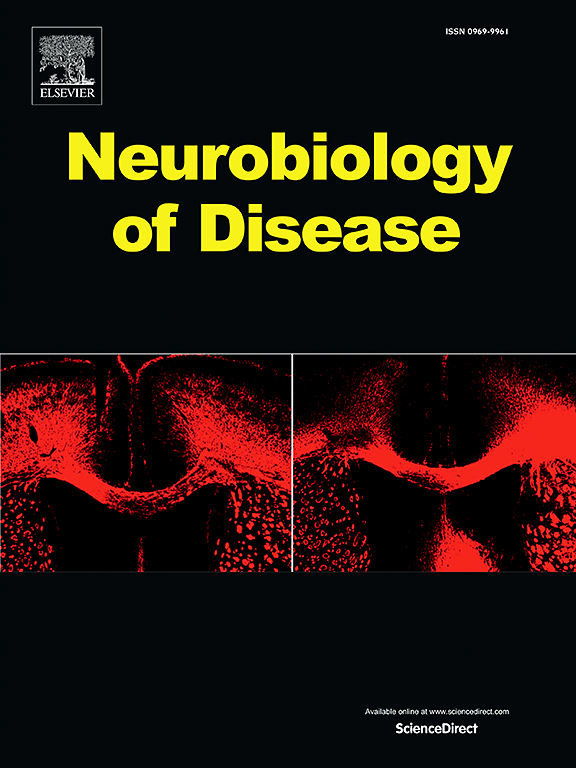脆性X综合征小鼠模型听觉反应中的皮层层特异性异常。
IF 5.6
2区 医学
Q1 NEUROSCIENCES
引用次数: 0
摘要
脆性X综合征(FXS)是自闭症谱系障碍(ASD)相关行为的主要遗传原因,包括感觉处理缺陷。听觉领域的感觉敏感性和时间加工缺陷会影响语言和认知功能的发展。FXS的小鼠模型Fmr1 KO显示出与FXS患者非常相似的听觉加工表型。体外皮层切片记录显示Fmr1 KO小鼠局部电路的层特异性差异,但尚不清楚这些差异如何转化为感觉处理的变化。在这项研究中,我们使用深度多电极记录了Fmr1 KO和野生型小鼠(WT)听觉皮层各层的体内峰值和局部场电位,并将后者转换为电流源密度(CSD)曲线,以提高空间分辨率分析。我们观察到,在KO小鼠中,CSD汇幅和试验间相位一致性降低,并且在时间调制刺激下试验间变异性增加。结果表明,KO小鼠的皮质层活动模式存在差异,浅层和深层的基线伽马功率较高,颗粒层的静息δ和θ功率较高。在KO小鼠中观察到CSD和峰值的试验间变异性显著升高。在KO小鼠中,对40 Hz的咔哒声或间隙的听觉稳态反应以层特异性的方式显示出相当大的试验到试验的可变性。Fmr1 KO小鼠听觉皮层中的神经发生器无法检测到噪声中的短间隙,这表明存在严重的时间加工缺陷。总之,本研究揭示了FXS中感觉超敏反应和时间加工缺陷的层特异性皮层机制。本文章由计算机程序翻译,如有差异,请以英文原文为准。
Cortical layer-specific abnormalities in auditory responses in a mouse model of Fragile X Syndrome
Fragile X Syndrome (FXS) is a leading genetic cause of autism spectrum disorders (ASD)- associated behaviors, including sensory processing deficits. Sensory sensitivity and temporal processing deficits in the auditory domain will affect development of language and cognitive functions. The mouse model for FXS, Fmr1 KO, has shown remarkably similar auditory processing phenotypes to patients with FXS. In vitro cortical slice recordings show layer-specific differences in Fmr1 KO mouse local circuits, but it is unclear how these differences translate to changes in sensory processing. In this study, we used a depth multielectrode to record in vivo spikes and local field potentials across layers of the auditory cortex in Fmr1 KO and wildtype mice (WT), converting the latter to current source density (CSD) profiles for improved spatial resolution analysis. We observed reduced CSD sink amplitudes and inter-trial phase coherence, and an increase in trial-to-trial variability for temporally modulated stimuli in the KO mice. Results indicated a differential cortical layer pattern of activity in KO mice, with higher baseline gamma power in superficial and deep layers and higher resting delta and theta power in granular layers. Significantly elevated inter-trial variability was observed for CSD and spikes in KO mice. Auditory steady state responses to clicks or gaps at 40 Hz showed considerable trial-to-trial variability in a layer-specific manner in KO mice. Neural generators in the Fmr1 KO mouse auditory cortex failed to detect short gaps in noise, indicating severe temporal processing deficits. Altogether, this study indicates layer-specific cortical mechanisms of sensory hypersensitivity and temporal processing deficits in FXS.
求助全文
通过发布文献求助,成功后即可免费获取论文全文。
去求助
来源期刊

Neurobiology of Disease
医学-神经科学
CiteScore
11.20
自引率
3.30%
发文量
270
审稿时长
76 days
期刊介绍:
Neurobiology of Disease is a major international journal at the interface between basic and clinical neuroscience. The journal provides a forum for the publication of top quality research papers on: molecular and cellular definitions of disease mechanisms, the neural systems and underpinning behavioral disorders, the genetics of inherited neurological and psychiatric diseases, nervous system aging, and findings relevant to the development of new therapies.
 求助内容:
求助内容: 应助结果提醒方式:
应助结果提醒方式:


